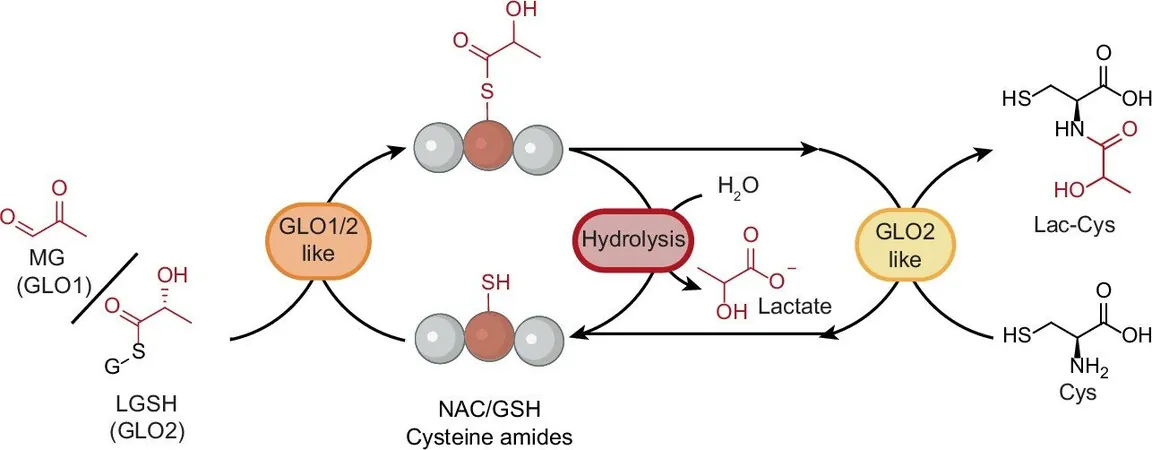
Breakthrough Discovery: A Sweet Connection Between Sugar Metabolism and Cellular Defense!
2025-06-04
Author: Sarah
When we indulge in sugary treats, our bodies spring into action, converting sugar and starch into energy through a vital process known as glycolysis. But there’s a dark side to this energy boost—glycolysis produces harmful byproducts linked to serious health issues like diabetes and age-related ailments.
A groundbreaking study from Aarhus University’s Department of Forensic Medicine flips the narrative! Instead of focusing solely on the detrimental effects of these byproducts, researchers have uncovered a fascinating link between sugar metabolism and our body's protective mechanisms.
The Science Behind the Discovery
Published in the journal Nature Chemical Biology, this revolutionary research reveals that two key byproducts of sugar metabolism—methylglyoxal and its derivative lactoylglutathione—interact with cysteine, a naturally occurring amino acid. This interaction happens at lightning speed!
Professor Mogens Johannsen, a leading researcher on the study, explains, "These reactions are intriguing because they involve cysteine and yield products that can be released from proteins. The rapid reaction with lactoylglutathione is particularly significant as it likely plays a crucial signaling role within cells." He adds that emerging studies highlight how these cysteine reaction products help cells adapt and defend themselves—functioning like a thermostat for cellular health!
A Double-Edged Sword?
Historically, methylglyoxal was known predominantly for its role in slow, damaging, and irreversible reactions with arginine, contributing to health issues like diabetes and aging. This new insight challenges that notion and opens bright possibilities for medical science.
Implications for Anti-Aging Strategies
The implications of this discovery are profound. It paves the way for new theories on how cells could detect distress signals and activate their protective mechanisms, potentially revolutionizing our approach to treating diabetes and age-related diseases. Who knows? This research might even sculpt the future of anti-aging strategies!
"We're thrilled with this finding, as it shifts focus from slow, harmful reactions to fast, reversible ones that could signify cellular regulatory functions," exclaims Ph.D. Jakob Hansen, another key researcher involved in the study.
Future Research Directions
The next frontier involves mapping these rapid reactions in detail to comprehend their role in cellular defense mechanisms and whether we can harness these processes for therapeutic gain.
Thanks to an advanced metabolomics technique developed at the Department of Forensic Medicine, researchers are capable of analyzing the intricate dance of chemical reactions in living cells. This method promises to unlock further secrets, including how various drugs or illicit substances interact with our body’s substances, paving the way for the discovery of revolutionary new biomarkers.


 Brasil (PT)
Brasil (PT)
 Canada (EN)
Canada (EN)
 Chile (ES)
Chile (ES)
 Česko (CS)
Česko (CS)
 대한민국 (KO)
대한민국 (KO)
 España (ES)
España (ES)
 France (FR)
France (FR)
 Hong Kong (EN)
Hong Kong (EN)
 Italia (IT)
Italia (IT)
 日本 (JA)
日本 (JA)
 Magyarország (HU)
Magyarország (HU)
 Norge (NO)
Norge (NO)
 Polska (PL)
Polska (PL)
 Schweiz (DE)
Schweiz (DE)
 Singapore (EN)
Singapore (EN)
 Sverige (SV)
Sverige (SV)
 Suomi (FI)
Suomi (FI)
 Türkiye (TR)
Türkiye (TR)
 الإمارات العربية المتحدة (AR)
الإمارات العربية المتحدة (AR)